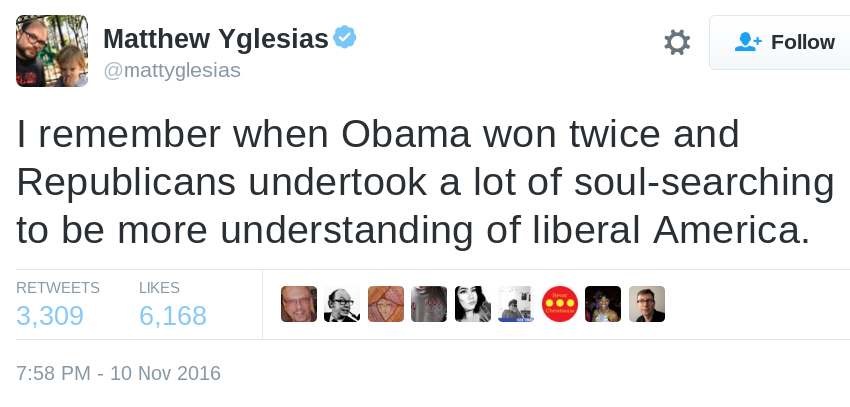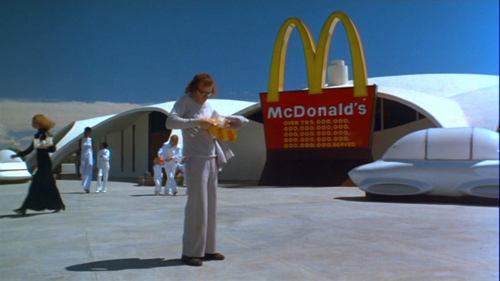The election was all about the economic downfall of Caucasian males, or maybe it wasn’t. Analysts disagree.
Some (like me) view it as an ugly expression of identity politics by white Americans who fear a more diverse future that has all but arrived, and that includes Trump voters in big cities as well as small hamlets, the ones who are dismayed that the nation has become too “politically correct,” which is essentially a complaint that they can’t use slurs anymore without consequence. Others see the stomach-turning election results as an expression of frustration by forgotten voters who wanted to rage against the machine, though it’s difficult to accept that anyone believes Trump will “drain the swamp” when he’s flanked by Gingrich and Giuliani, two creatures from the black lagoon who’ve been feasting on a corrupt system the majority of their adult lives.
The truth probably lies somewhere in between, though the dormant racial and xenophobic hatred awakened by Trump, which has expressed itself repeatedly in words and deeds, was always there and it can’t be explained away by economic fears. It’s heartbreaking that so many of us pulled the lever for a candidate who ran a shameful, fascistic campaign of bigotry, full of anti-Muslim rhetoric, misogynistic insults and anti-Semitic memes.
An amoral enabler like Peter Thiel supported and emboldened such a disgraceful figure–and one who’s wholly unprepared for the job–because of his fealty to his idiotic theories, and anyone who labels him a “winner” of the election defines that word differently than I do. As part of the new administration’s transition team, he has a lot of work to do, but so did Hitler’s secretary. That many consider him a serious intellectual because of his billions and contrarian “ideas” is appalling.
The clearest view in the wake of the election is that we’re still exceptionally divided, with Hillary Clinton set to win the popular vote by probably more than two million while losing the election overall. Outside of racial lines, the fissure is probably strongest in geography, with those on the coasts now being referred to as “elites” who don’t listen to what Sarah Palin used to call the “real America.”
When Charles Murray and Thiel rail against so-called liberal elites, I have to laugh. Having grown up in a very blue-collar background, it’s hard to accept those who’ve spent their whole lives in the halls of power posturing as if they’re horse whisperers to the poor. They’re not; they’re opportunists in love with ideology far more than people.
The idea that tone-deaf people in NYC, SF, DC and LA selfishly make decisions that effect the lives of those in the middle of the country is maddening, because those same folks choose congresspeople, senators and Presidents without calling the coasts first, and no one expects them to. Those decisions impact citizens living in major metropolises in a real way and not always for the better. We’re all living in bubbles now, and that may cause problems, but that’s on all of us, not just some.
Culturally and economically, however, it does appear urban and rural Americans have different needs, a situation growing more extreme. Two excerpts follow.
From “The Election Highlighted a Growing Rural-Urban Split,” by Emily Badger, Quoctrung Bui and Adam Pearce of the New York Times:
The widening political divergence between cities and small-town America also reflects a growing alienation between the two groups, and a sense — perhaps accurate — that their fates are not connected.
The University of Wisconsin political scientist Katherine J. Cramer, the author of The Politics of Resentment, described what this looked like during years of field research in Wisconsin in an insightful interview with Jeff Guo at The Washington Post. The people she met across a state that Mrs. Clinton ultimately lost felt deeply disrespected (and suspicious of a white-collar academic from uber-blue Madison). “They would say, ‘The real kicker is that people in the city don’t understand us,’ ” Ms. Cramer said. “ ‘They don’t understand what rural life is like, what’s important to us and what challenges that we’re facing. They think we’re a bunch of redneck racists.’ ”
Cities, for their part, are easily branded with some dissonance as embodying either professional elites or poor people who don’t deserve benefits (thus both Madison and Milwaukee, two very different places, come in for equal resentment within Wisconsin). Many of the young Democratic voters who live in blue cities like these, as Alec MacGillis has noted, have gravitated away from redder parts of the country from which they felt alienated. “There’s just nothing to do in Ohio,” lamented one voter who grew up there but now lives in Los Angeles. “The jobs are limited, but it’s not just the jobs and the industries that are in Ohio, it’s the mind-set that I didn’t gravitate to.”
As the relationship between density and partisanship has grown stronger over the last half-century, the structure of the economy has also changed in ways that reinforce the divide.•
From Patrick Thornton’s Roll Call essay “I’m a Coastal Elite From the Midwest: The Real Bubble is Rural America“:
To pin this election on the coastal elite is a cop-out. It’s intellectually dishonest, and it’s beneath us.
We, as a culture, have to stop infantilizing and deifying rural and white working-class Americans. Their experience is not more of a real American experience than anyone else’s, but when we say that it is, we give people a pass from seeing and understanding more of their country. More Americans need to see more of the United States. They need to shake hands with a Muslim, or talk soccer with a middle aged lesbian, or attend a lecture by a female business executive.
We must start asking all Americans to be their better selves. We must all understand that America is a melting pot and that none of us has a more authentic American experience.
If we pin this election on coastal elites, we are excusing white working-class and rural Americans for voting for a man accused of violating the Fair Housing Act by refusing to rent apartments to black people. If we pin this election on coastal elites, we are excusing white working-class and rural Americans for voting for a man who called Mexicans rapists, drug dealers and criminals. If we pin this election on coastal elites, we are excusing white working-class and rural Americans for voting for a man who called for a complete ban on Muslim immigration.•




